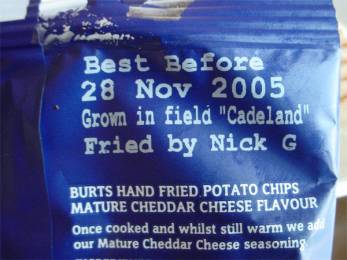
Food & drink
Imagine if that car was a hamburger
According to Dara O'Rourke, Professor of labour at U.C. Berkley, the humble bar code (or RFID tag for that matter) could herald a customer revolution. At present such codes provide critical information for retailers but there is no reason why this couldn't be turned around to provide information to customers. For example they could help a customer to find out where an egg is from, when it was laid, what the chicken was fed or even look at the bird's living conditions. A flight of fancy? Not at all. Software has already been invented to allow mobile phone users to scan bar codes and companies like Heritage Foods (US) are already providing all of the above including a web-cam link to their farm. Meanwhile a company called HyperActive Technologies (US) has developed software that can predict what you eat based on the type of car you drive. The idea works by taking a photograph of your car as you drive into a fast food restaurant. Software then identifies the make and model of car and compares this data to what drivers of similar cars have ordered in the past. An order is then sent to the kitchen, which starts preparing your Chicken Nuggets before you step out of your car. Why? Simple, food is only really fast when it's prepared in advance so a few minutes warning can make a lot of difference. McDonalds, Taco Bell and Burger King are all testing the technology and wait times are said to have fallen by at least a minute. Staff-retention levels have also improved because kitchen stress levels have declined.
Ref: New York Times (US) 12 December 2004, 'The Augmented Bar Code', N. Johnson New York Times 12 December 2005, 'McProfiling', S. Mihn. www.nytimes.com
Latest food trends
According to Mintel's Global New Products Database (GNPD) the big new trends in food include a move towards more exotic flavours, the continued rise of natural and organic ingredients (in cosmetics and toiletries as well as food products), the growth of Glycemic Index (GI) labelling, a growing interest in portion control and the decline of the low carb lifestyle. Other trends include the use of red wine as an ingredient in skincare products, an increased interest in amino acids (already big in Japan) and a shift towards 'mid-positioned' products (e.g. mid-calorie products like Kraft Foods' 100 calorie packs and half-sugar, half salt and half caffeine products). Another big trend is the idea of 'balance' and products that help people to relax and de-stress. Finally, at the really faddish end of things, you can now buy home-baking kits - for pets. That's right, biscuits you can make and bake at home for dogs and cats.
Ref: Mintel.com (UK), 5 February 2005. (thanks to Helen Jones).
What's next - canned laughter?
One of the largest brewers in the world, Anheuser-Busch (US) has launched a beer that contains caffeine together with guarana and ginseng. Called B-to-the E (BE) the 'beer' apparently tastes of blackberry, raspberry, cherry and (oh yes) hops. Personally we can't see the point of it at all unless it's a way of getting drunk but not falling asleep next to someone you don't know (then again is it supposed to wake you up or send you to sleep?). Even more ridiculous is an idea from a company called Languedoc in South Africa. H2Olive is a bottled drink made from olive oil which apparently addresses “inner and outer beauty”. The drink contains 12% olive oil, leaf extracts and mineral water together with a range of flavours including lychee and pomegranate. Our favourite is their straight oil and water mix drink (kidding).
Ref: www.anheuser-busch.com/news/BtoE_100404.htm Springwise (Neth) Issue 20, February 2005. www.springwise.com
Chocolate vaults
As we've pointed out before, most markets seem to be polarising between low cost products and luxury segments. The food market is no different with supermarket aisles full of either no frills basics or expensive, artisan products. A new example is chocolate, which in Japan is taking on the look and language of fine wine. The Mitsukoshi department store in the Nihonbashi district of Tokyo has opened up a temperature and humidity controlled chocolate cellar called the Satie Dominique Chocolat. There have been specialist chocolate shops before but the idea of taking the packaging and display techniques of fine wine and cigars and applying them to confectionery is relatively new.
Ref: Japan Today, reported in Sense Bulletin 14 February 2005. www.senseworldwide.com
An intolerant society
Why are so many people so intolerant of certain types of foods all of a sudden? In the UK about 25% of people claim they have a food allergy or intolerance of some kind and the figures are much the same in most other westernised societies. One explanation in Europe is that it's all a reaction to the various food scares of recent years but this obviously doesn't explain the trend further afield. Other plausible explanations include the level of processed foods now being consumed, increased food fanaticism or 'remembered food experiences' (a negative previous encounter with a peanut). According to some estimates about 5% of the UK population really do have a specific food allergy - which is quite different to a food sensitivity or intolerance. At the most extreme end of the spectrum there's also coeliac which is triggered by gluten in wheat. Another problem is that some people with so-called sensitivities rely on tests using a Vega machine that many experts dismiss as witchdoctory. Whatever the reason the trend does demonstrate our increased obsession with food and the fact that there is a growing awareness that what we eat affects not only physical shape but mood and mental health.
Ref: Various including The Times (UK) 22 January 2005. 'Wheat-watchers: going against the grain'. S.Compton. www.timesonline.co.uk
